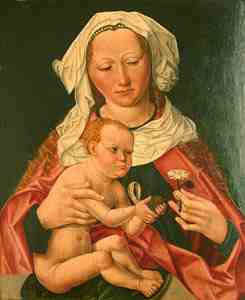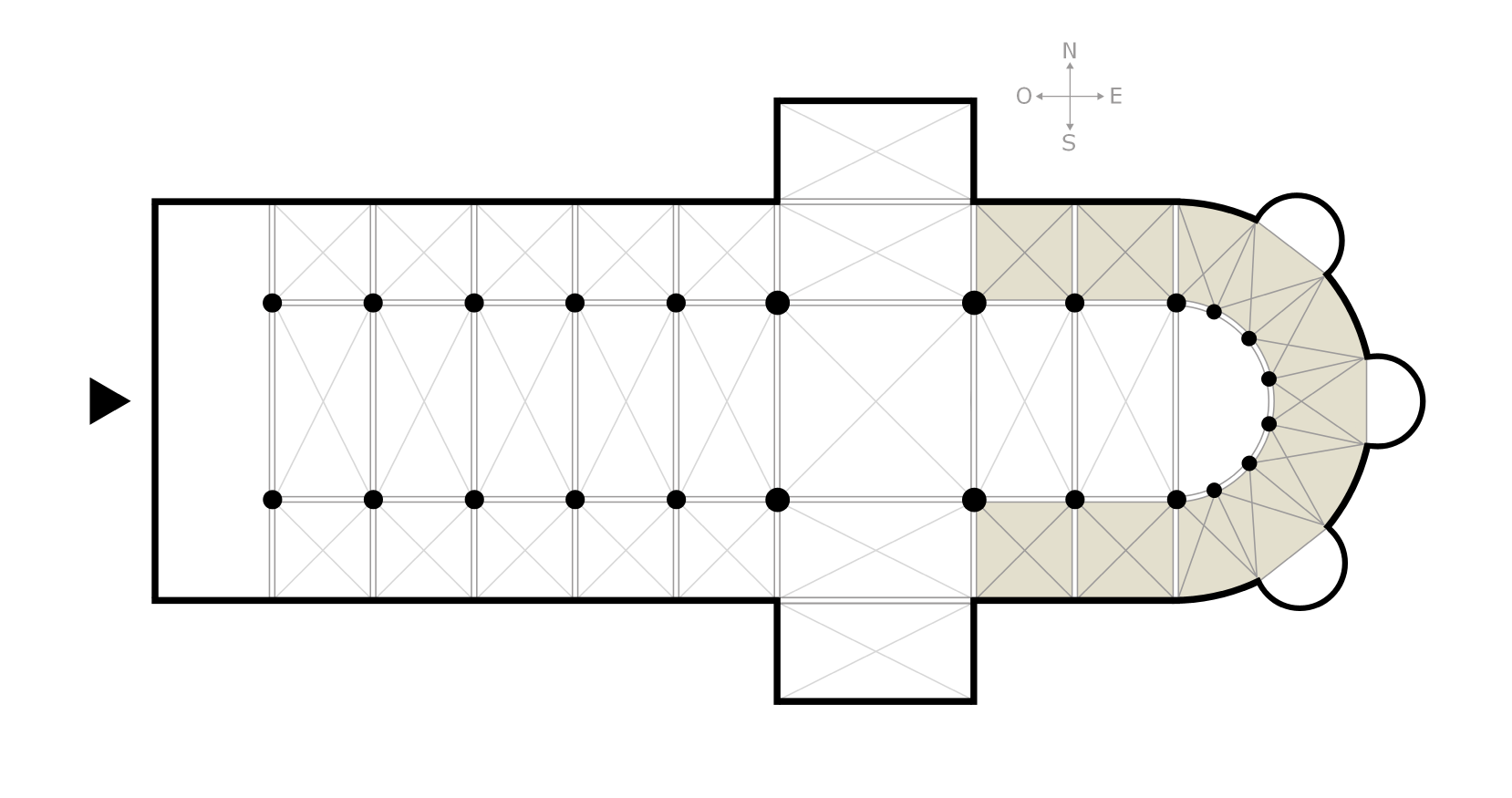|
Master Of The Bützow Altarpiece
The Master of the Bützow Altarpiece was a German painter, active in the area around Lübeck around 1500 and influenced by the work of Wilm Dedeke. They are named for a major altarpiece painted for the church of Bützow, still held in the ambulatory of the church.Hegner 2015 The Bützow altar is composed of two pairs of gates, the first fixed and sculpted, the second movable and painted. The second gates are painted with four saints on the outside eight scenes from the life of Saint Anne and the Virgin Mary on the inside. The altarpieces and predella In art a predella (plural predelle) is the lowest part of an altarpiece, sometimes forming a platform or step, and the painting or sculpture along it, at the bottom of an altarpiece, sometimes with a single much larger main scene above, but oft ... of the altar in the church of the Madonna of Singo in Sweden and the battens of the altar to Saint Anne in Trodens (now stored at the Museum of Bergen in Norway) are also attributed ... [...More Info...] [...Related Items...] OR: [Wikipedia] [Google] [Baidu] |
Lübeck
Lübeck (; Low German also ), officially the Hanseatic City of Lübeck (german: Hansestadt Lübeck), is a city in Northern Germany. With around 217,000 inhabitants, Lübeck is the second-largest city on the German Baltic coast and in the state of Schleswig-Holstein, after its capital of Kiel, and is the 35th-largest city in Germany. The city lies in Holstein, northeast of Hamburg, on the mouth of the River Trave, which flows into the Bay of Lübeck in the borough of Travemünde, and on the Trave's tributary Wakenitz. The city is part of the Hamburg Metropolitan Region, and is the southwesternmost city on the Baltic, as well as the closest point of access to the Baltic from Hamburg. The port of Lübeck is the second-largest German Baltic port after the port of Rostock. The city lies in the Northern Low Saxon dialect area of Low German. Lübeck is famous for having been the cradle and the ''de facto'' capital of the Hanseatic League. Its city centre is Germany's most e ... [...More Info...] [...Related Items...] OR: [Wikipedia] [Google] [Baidu] |
Wilm Dedeke
Wilm Dedeke ( – 1528) was a late gothic painter from Northern Germany. He was born in Lübeck. Dedeke completed the Altar of St. Luke (Lukas-Altar) at the Hamburg Mariendom in 1499 for the Hamburg Guild of Saint Luke. It had been left unfinished by his late colleagues Hinrik Bornemann and Absolon Stumme; Dedeke married the widow of the latter man. In 1502 he attained the title of Master of the Brotherhood of St. Thomas.Gmelin, Hans Georg"Dedeke, Wilm."In Grove Art Online. Oxford Art Online, (accessed 3 February 2012; subscription required). He has been identified with the anonymous "Master of the Halepagen Altar". second column was into info box --> * Hans von Aachen (1552–1615) * Aatifi (born 1965) * Karl Abt (1899–1985) * Tomma Abts (born 1967) * Andreas Achenbach (1815–1910) * Oswald Achenbach (182 ... References External links * Wilm Dedeke on the website of the Museum of Schleswig-Holstein(In German) 1460 births 1528 deaths Artists from Lübeck ... [...More Info...] [...Related Items...] OR: [Wikipedia] [Google] [Baidu] |
Bützow
Bützow is a town in the district of Rostock in Mecklenburg-Vorpommern in north-eastern Germany, centered on Bützower See. History The town was first mentioned in 1171. From 1815 to 1918 Bützow was part of the Grand Duchy of Mecklenburg-Schwerin, from 1871 within the German Empire. From 1933 to 1945, during Nazi rule and World War II, a Nazi prison was operated in the Dreibergen district with multiple forced labour subcamps located in various places in the region. After the war, the town was part of East Germany until 1990. On 5 May 2015, the town was struck by an F3 tornado which caused severe damage to many buildings, including the local hospital. Culture Medieval Bützow Castle is located in Bützow. The town also has a medieval Brick Gothic church, which contains an altarpiece An altarpiece is an artwork such as a painting, sculpture or relief representing a religious subject made for placing at the back of or behind the altar of a Christian church. Though most c ... [...More Info...] [...Related Items...] OR: [Wikipedia] [Google] [Baidu] |
Ambulatory
The ambulatory ( la, ambulatorium, ‘walking place’) is the covered passage around a cloister or the processional way around the east end of a cathedral or large church and behind the high altar. The first ambulatory was in France in the 11th century but by the 13th century ambulatories had been introduced in England and many English cathedrals were extended to provide an ambulatory. The same feature is often found in Indian architecture and Buddhist architecture generally, especially in older periods. Ritual circumambulation or parikrama around a stupa or cult image is important in Buddhism and Hinduism. Often the whole building was circumambulated, often many times. The Buddhist chaitya hall always allowed a path for this, and the Durga temple, Aihole (7th or 8th century) is a famous Hindu example. The term is also used to describe a garden feature in the grounds of a country house. A typical example is the one shown, which stands in the grounds of Horton Court in Glouce ... [...More Info...] [...Related Items...] OR: [Wikipedia] [Google] [Baidu] |
Saint Anne
According to Christian apocryphal and Islamic tradition, Saint Anne was the mother of Mary and the maternal grandmother of Jesus. Mary's mother is not named in the canonical gospels. In writing, Anne's name and that of her husband Joachim come only from New Testament apocrypha, of which the Gospel of James (written perhaps around 150) seems to be the earliest that mentions them. The mother of Mary is mentioned but not named in the Quran. Christian tradition The story is similar to that of Samuel, whose mother Hannah ( he, ''Ḥannāh'' "favour, grace"; etymologically the same name as Anne) had also been childless. The Immaculate Conception was eventually made dogma by the Catholic Church following an increased devotion to Anne in the 12th century. Dedications to Anne in Eastern Christianity occur as early as the 6th century. In the Eastern Orthodox tradition, Anne and Joachim are ascribed the title ''Ancestors of God'', and both the Nativity of Mary and the Presenta ... [...More Info...] [...Related Items...] OR: [Wikipedia] [Google] [Baidu] |
Predella
In art a predella (plural predelle) is the lowest part of an altarpiece, sometimes forming a platform or step, and the painting or sculpture along it, at the bottom of an altarpiece, sometimes with a single much larger main scene above, but often (especially in earlier examples), a polyptych or multipanel altarpiece. In late medieval and Renaissance altarpieces, where the main panel consisted of a scene with large figures, it was normal to include a predella below with a number of small-scale narrative paintings depicting events from the life of the dedicatee, whether the ''Life of Christ'', the ''Life of the Virgin'' or a saint. Typically there would be three to five small scenes, in a horizontal format. Sometimes a single space shows different scenes in continuous representation. They are significant in art history, as the artist had more freedom from iconographic conventions than in the main panel as they could only be seen from close up. As the main panels themselves ... [...More Info...] [...Related Items...] OR: [Wikipedia] [Google] [Baidu] |
15th-century German Painters
The 15th century was the century which spans the Julian dates from 1 January 1401 ( MCDI) to 31 December 1500 ( MD). In Europe, the 15th century includes parts of the Late Middle Ages, the Early Renaissance, and the early modern period. Many technological, social and cultural developments of the 15th century can in retrospect be seen as heralding the "European miracle" of the following centuries. The architectural perspective, and the modern fields which are known today as banking and accounting were founded in Italy. The Hundred Years' War ended with a decisive French victory over the English in the Battle of Castillon. Financial troubles in England following the conflict resulted in the Wars of the Roses, a series of dynastic wars for the throne of England. The conflicts ended with the defeat of Richard III by Henry VII at the Battle of Bosworth Field, establishing the Tudor dynasty in the later part of the century. Constantinople, known as the capital of the world an ... [...More Info...] [...Related Items...] OR: [Wikipedia] [Google] [Baidu] |
16th-century German Painters
The 16th century begins with the Julian year 1501 ( MDI) and ends with either the Julian or the Gregorian year 1600 ( MDC) (depending on the reckoning used; the Gregorian calendar introduced a lapse of 10 days in October 1582). The 16th century is regarded by historians as the century which saw the rise of Western civilization and the Islamic gunpowder empires. The Renaissance in Italy and Europe saw the emergence of important artists, authors and scientists, and led to the foundation of important subjects which include accounting and political science. Copernicus proposed the heliocentric universe, which was met with strong resistance, and Tycho Brahe refuted the theory of celestial spheres through observational measurement of the 1572 appearance of a Milky Way supernova. These events directly challenged the long-held notion of an immutable universe supported by Ptolemy and Aristotle, and led to major revolutions in astronomy and science. Galileo Galilei became a champion ... [...More Info...] [...Related Items...] OR: [Wikipedia] [Google] [Baidu] |



